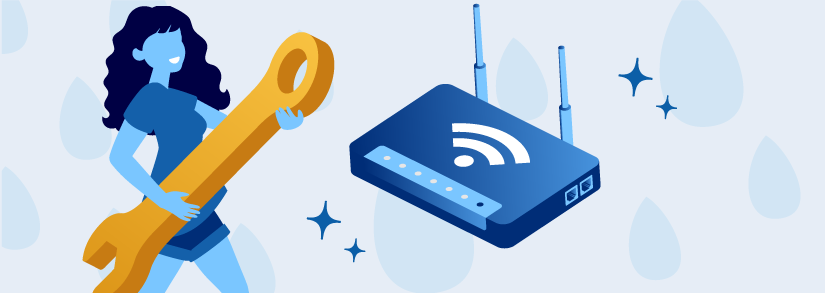Wi-Fi Not Working? A guide on How Rain Affects Internet & How to Resolve it

When we install a Wi-Fi router connection to our home or office, we just ask for one thing, good and uninterrupted connectivity. Whether it’s about playing games, binge-watching web series, working from home, or anything else, an unremitting Wi-Fi connection is crucial.
Especially on a rainy day, when we are stuck at home, we need great internet speed so that we do not get bored or our work is not stuck. But sadly, internet service becomes unusable at those times. This is not due to the negligence of your service provider; ‘Wi-Fi not working on a rainy day or storm’ is a common problem that is faced across the world.
Wi-Fi was first originated and launched in Hawaii in the year 1971 by the name ALOHAnet. It was developed at the University of Hawaii.
Have you also faced Wi-Fi issues during extremely bad weather conditions or rainy days? No more worries. In this article, we are going to explain why your Wi-Fi is not working and how can you fix it?
How does bad weather affect your internet and Wi-Fi router?
It is hard for everyone to believe that cloudy weather can slow down internet speeds; but have you ever wondered why it happens? Also, sometimes lightning can destroy your Wi-Fi lines too. There are scientific reasons behind this action; let’s discuss those reasons a little bit.
- Cloudy or rainy day affects satellite internet services
As we all know, Wi-Fi waves travel through radio signals; and it is hard when it is raining outside. Rain absorbs the signal which causes the interruption of your internet speed. Also, cloudy weather is responsible for the disturbing frequency of your service network.
- Thunderstorm diminish Wi-Fi signal
Wi-Fi routers are basically transmitters of electromagnetic signals and during heavy winds, rains, and storms these electrical signals cannot pick the Wi-Fi signals. This may decrease the speed of the transmission of the signal in case of close proximity or sometimes it can burn the circuit board of the Wi-Fi router.
- Other weather effects
Bad weather becomes a nightmare for not only satellite internet service, but also for fixed-line, DSL, wireless, fiber cable, and all kind of services. Heavy rain, storm, or snow can break or damage the cable and destroy the internet connection completely.
- High Traffic, Less speed
As we have mentioned earlier, no one likes to work out of the house on rainy days. This is a common excuse that allows us to spend time at home binge-watching online web series on Netflix or Amazon prime video. This brings high traffic to the service network and transmits less download speed throughout the day. People blame low speed for bad weather, but heavy traffic is another reason why service becomes disturbing in bad weather.
A human being is the best Wi-Fi signal blocker, as a human body is made of 75% water. If you are sitting between the router and device, the signal can become weaker.
How to resolve your Wi-Fi router?
Wi-Fi can be faulty for many reasons, but first, you have to identify what is the problem with the Wi-Fi router? Is your Wi-Fi connected but not working? Or Wi-Fi router is not working at all? Sometimes Wi-Fi is not working on laptops only.
Below we resolved all the problems that may be faced in bad weather. Let’s jump to the solution directly.
1. Reset
When there is a problem with any electronic device, we think of resetting it first. And we will not back down from doing it here also. Most of the time, the problem is solved by resetting your device only. Sometimes switching off the Wi-Fi router and then turning it on again, can increase the Wi-Fi internet speed.
This is the reason that a hard reset button is mounted on the side or bottom of the Wi-Fi router. If you hold it for few seconds, the whole system starts working again from the beginning. This technique can help you in most cases.
2. Frequency Configuration
A Wi-Fi router always needs a proper setting, especially in the case of bandwidth frequency. Most of the times, we can find, our Wi-Fi is connected but not working. During bad weather, service providers also reduce the bandwidth frequency due to high traffic which affects the internet connections. So, if we try to change it for example, if we change it from 5GHz to 2.5GHz, it might help increase the speed.
3. Clear caches
Sometimes the most common thing is clearing cache. The device memory can be filled with cache and deleting these files is one of the easiest methods to deal with this problem. If bad weather slows down your internet speed, you can clear cache files on the phone and also to your browser’s unnecessary histories. Truth be told; it really works not only in bad weather but also in any kind of poor internet connection.
4. Repositioning of Router
Basically, what happens is, we place our Wi-Fi router in a corner or somewhere where we may get the right speed most of the time. Therefore, when the weather is bad, the radio signal cannot reach just as well to that corner. Also, if you are using a wireless router, then it is better to keep it in distance from microwave, washing machine, and other electronic devices. We suggest you put your Wi-Fi router in a central location or in that room, where you can stay near it. Less distance and no barriers can help to provide you a better network coverage.
5. Better Quality Router
It may be hard to believe but a cheap router is another big reason behind your Wi-Fi not working problem. Short rains or gusts of wind can also cause Wi-Fi issues. That’s why we recommend you to buy a well-known company’s router which has high signal strength and is able to protect themselves from such bad situations. There are many good-quality routers available on the market today that will not be affected by lightning or heavy rain.
Dos and Don’ts to follow if bad weather affects internet service
| DO | DON’T |
|---|---|
|
|
Conclusion
We always give such a hard time to the service provider for bad Wi-Fi connection. Although, most of those are due to their poor services. But today, we have discussed how bad weather can also be the reason for poor connectivity and how it can be resolved. We have covered all the important information in one article and hope after reading this article; no one will ask “Why my Wi-Fi is not working” anymore.
